Premium
His Highness the Aga Khan IV: End of an Era
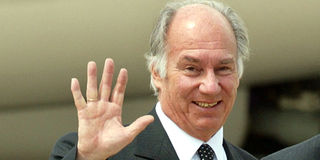
The Aga Khan, 49th Hereditary Imam of Shia Imami Ismaili Muslims, waves after his arrival at Madrid's Torrejon airbase, Spain May 21, 2004.
What you need to know:
- A direct descendant of Prophet Mohammed, the Aga Khan was globally recognised for his philanthropy and commitment to improving lives, irrespective of race, gender, ethnicity or religion.
- Over the years, as he combined philanthropy and business, the Aga Khan became more than a religious leader.
The passing of His Highness the Aga Khan, the spiritual leader of the Shia Ismaili Muslims and founder of the Aga Khan Development Network (AKDN), marks the end of a legacy defined by unparalleled vision, generosity and philanthropy.
Prince Karim al-Hussaini Aga Khan IV died in Lisbon, Portugal, on Tuesday, February 4, surrounded by his family. He was 88.
The death signifies the end of an era for millions who revered him not only as their Imam, but also as a visionary leader, institution builder and champion of progress.
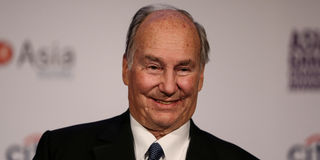
The Aga Khan, founder of Aga Khan Development Network, gives a speech at the 2017 Asia Game Changer Awards and Gala Dinner in Manhattan, New York, US November 1, 2017.
While announcing his death, the AKDN stated that his successor would be named after his will is read in the coming days. According to the Ismaili community’s website, the successor is chosen from among his male progeny or other relatives.
A direct descendant of Prophet Mohammed, the Aga Khan was globally recognised for his philanthropy and commitment to improving lives, irrespective of race, gender, ethnicity or religion.
Over the years, as he combined philanthropy and business, the Aga Khan became more than a religious leader.
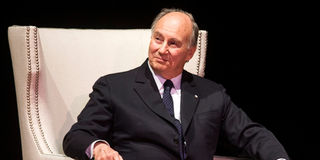
The Aga Khan, spiritual leader of Ismaili Muslims, looks on during a speaking event at Massey Hall in Toronto, February 28, 2014.
He became a statesman without borders, a patron of culture, an advocate for education and a steward of sustainable development.
His vision not only reshaped communities across the globe, particularly in Africa, South Asia and Central Asia, where his network of schools, hospitals, and economic projects uplifted countless lives, but was given head of state treatment in the nations he visited.
Throughout his life, Aga Khan IV championed the belief that Islam is a thinking, spiritual faith that teaches compassion, tolerance and the dignity of humankind.
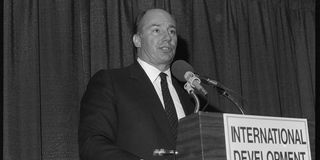
His Highness the Aga Khan addresses the audience at an award ceremony and dinner during the 35th anniversary International Development convention at the Washington, DC Convention Center. March 18, 1987
“He dedicated his life to the principle that faith must inspire progress, that knowledge must serve humanity and that prosperity must be shared,” read an official statement released from Portugal following his passing.

US Secretary of State Hillary Clinton (R) talks to the Aga Khan at the 'Afghanistan: The London Conference' in central London, January 28, 2010.
Born in Geneva, Switzerland, on December 13, 1936, to Prince Aly Khan and British-born Joan Yarde-Buller, Prince Karim spent his early years in Nairobi during the turbulent years of WWII.
His time in Kenya nurtured his deep connection to East Africa, a region that would later become a pillar of his development initiatives. Educated at the prestigious Le Rosey School in Switzerland, he later attended Harvard University, where he immersed himself in the study of Islamic history and hoped to achieve a doctorate.
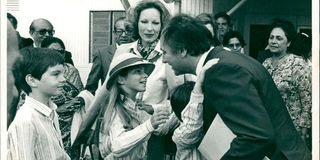
"We'll see you safely, Daddy," is in the eyes of Princess Zahra who rushes for second place to embrace her father, His Highness The Aga Khan. The family were pictured on March 7, 1981, at Wilson Airport before they departed from Nairobi to the Mara Serena Game Lodge. Prince Hussain is pictured hugging his father while Prince Rahim (left) waits his turn.
Fate intervened in 1957. His grandfather, Sir Sultan Mahomed Shah Aga Khan III, passed away, and the responsibility of leading the Ismaili community fell on his shoulders at the young age of 20, rather than his father.
The transition was profound. He set aside his ambitions of pursuing a PhD and his passion for soccer to take on the spiritual and administrative leadership of a global community.
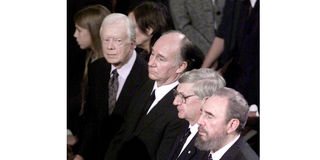
Former US President Jimmy Carter (L-R), the Aga Khan, former Canadian Governor-General Romeo LeBlanc and Cuban President Fidel Castro attend the state funeral for former Canadian Prime Minister Pierre Trudeau in Montreal, October 3, 2000.
For more than six decades, the Aga Khan transformed his leadership into a mission of service. The AKDN, his brainchild, became one of the world’s largest private development agencies, operating in more than 30 countries.
His initiatives ranged from world-class hospitals and universities to cultural restoration projects, economic ventures and environmental conservation.
His commitment to pluralism and social harmony earned him recognition from world leaders, and his influence extended beyond the Ismaili community to the broader global stage.

His Highness the Aga Khan and His Royal Highness the Prince of Wales at Buckingham Palace. Ian Jones LONDON - UK - 12th March 2019: HRH The Prince of Wales hosts a dinner for the Prince's Trust International at Buckingham Palace in London.
His legacy in Africa remains profound. From the establishment of Aga Khan University in Nairobi, Aga Khan University Hospital, to the revitalisation of historic cities like Zanzibar’s Stone Town, his projects underscored his belief that development must be holistic; incorporating education, health, culture and economic empowerment.
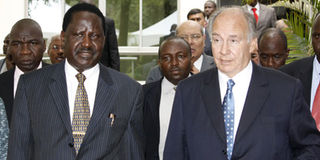
Prime Minister Raila Odinga (left) and His Highness The Aga Khan arrive for the official unveiling of the Aga Khan University Graduate School of Media and Communication on July 27, 2011.
Though born into a lineage of leadership, the Aga Khan carried the mantle of the 49th Imam of the Shia Ismaili Muslims with grace and a profound sense of duty, with his vision extending far beyond religious guidance.
His philanthropy reshaped landscapes, bridging cultures and fostering development in some of the world’s most vulnerable regions.
Education, healthcare and economic empowerment were the cornerstones of his work, every initiative reflecting his unwavering belief in the power of knowledge, compassion and enterprise.
By the time of his passing, the Aga Khan’s legacy had become woven into the fabric of nations, particularly in Kenya, where his name is etched into institutions that continue to uplift lives.
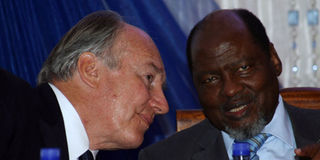
His Highness The Aga Khan (left) and former Mozambique President Joachim Chissano during the media awards gala night on March 18, 2010.
Aga Khan Schools, The Aga Khan University Hospital and its satellite facilities stand as testament to his commitment to excellence and service. Through the Aga Khan Fund for Economic Development (AKFED), he championed sustainable progress, and once remarked: “The AKFED does seek to generate profits, but they are entirely reinvested in future development initiatives.”
Similarly, the AKDN has over the years remained a beacon of his vision, playing a major role in sectors ranging from health, education and culture to rural development and economic empowerment.
Its presence in Kenya is deeply felt through investments in the Nation Media Group Plc, Industrial Promotion Services (Kenya) Ltd, Allpack Industries Ltd, Farmer’s Choice Ltd, Premier Food Industries Ltd, Tourism Promotion Services Eastern Africa Ltd among others.
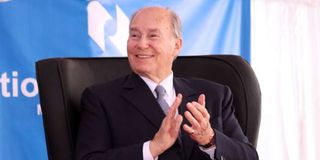
His Highness the Aga Khan during the launch of Nation Media Group's new printing press along Mombasa Road, Nairobi, on March 17, 2016.
AKDN has also shaped communities across other parts of Africa, Asia and the Middle East, fostering progress in some of the world’s most under-served regions.
The throne
The Aga Khan came to the throne through his grandfather’s goodwill. It all started on the early morning of July 11, 1957, when Sir Sultan Mahomed Shah Aga Khan III passed away, just weeks shy of his 80th birthday.
On the afternoon of July 12, the Aga Khan’s family gathered at the villa to hear the reading of his will, which had been securely stored at Lloyd’s Bank in London.
The will would radically depart from tradition, and revealed a decision that would not only shape the future of the Shia Muslim Ismaili community, but the many spheres the new Aga Khan touched.
“In view of the fundamentally altered conditions of the world in very recent years and the great changes which have taken place, including the discovery of atomic science, I am convinced that it is in the best interest of the Shia Muslim Ismaili Community that I be succeeded by a young man who has been brought up and developed during recent years in the midst of a new age and who will bring a new outlook on life to his office of Imam. For these reasons, I appoint my grandson Karim, the son of my son Aly Salomone Khan, to succeed to the title of Aga Khan and to the Imam and Pir of all Shia Ismaili followers,” it said.
Thus, as the globe mourned a leader described by The Guardian as “a Citizen of the World,” attention also swiftly turned to the 20-year-old Prince Karim, who was to carry the title of Aga Khan IV, a position he would hold for almost seven decades.
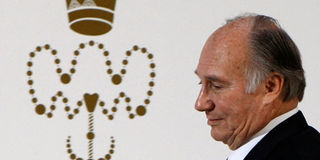
The Aga Khan, spiritual leader of Ismaili Muslim sect, takes part in the opening ceremony of the new delegation of the Ismaili Imamat in Ottawa December 6, 2008.
From the outset, he was mentored by his grandfather’s widow, the Begum, as he navigated the immense responsibilities before him. Having been close to his grandfather, he had the rare privilege of working alongside him in his final months, gaining invaluable insight and guidance.
Upon assuming leadership, he told the press: “I follow a very great man in very great responsibilities. In the last months, I had the honour of working closely with my grandfather and being guided by him. He expressly wished for me to benefit from the Begum’s extensive knowledge of the Ismaili community and their affairs.”
This confluence of mentorship and academic rigour prepared the young Imam to embrace his role with a vision deeply-rooted in tradition yet attuned to the evolving demands of modernity.
At the time of his grandfather’s passing, Karim was deeply immersed in the study of Islamic history at Harvard. As the 49th hereditary Imam of the Ismailis, the young Karim had to set aside his ambitions of pursuing a doctorate in history at Harvard and his passion for soccer – as he became the spiritual leader of millions of Ismailis spread across India, Kenya, Pakistan, Bangladesh, Egypt, Canada and the former Soviet republics.
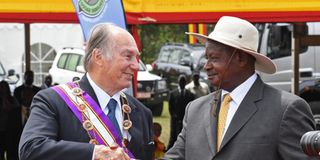
His Highness the Aga Khan greets Uganda President Yoweri Museveni at a past meeting.
Prince Karim followed the footsteps of his grandfather, Sir Sultan Mahomed Shah Aga Khan III, who once served as a president of the League of Nations in 1937. Besides the great responsibility bestowed upon him, the Aga Khan had one enduring wish that illustrated his deep love for education.
“I would like to finish Harvard. If I can get back for my last year and still carry on my responsibilities as I think they should be carried on, I will go back,” he stated just days after assuming his role. True to his word, he later returned to Harvard and graduated with an honours degree in Islamic Studies.
Many years later, Harvard recognised his contributions by awarding him an Honorary Doctor of Laws.
After becoming the leader of the Ismaili community, Aga Khan started an extensive tour that took him to several countries for his enthronement ceremonies, known as Takht Nashini.
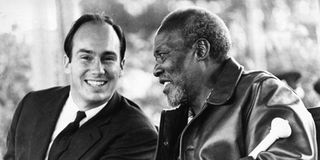
President Jomo Kenyatta has a word with HH the Aga Khan while watching displays of traditional dancing after the State House lunch during Kenyatta day on October 20, 1966.
These ceremonies, held in Nairobi, Dar es Salaam, Kampala, Karachi, Dhaka and Bombay – now Mumbai – saw the Aga Khan receive the symbolic Sword of Justice, followed by the signet ring.
He was also welcomed as an international spiritual leader, often accorded near-head-of-state recognition. This elevated his standing among global leaders, fostering relationships that would later strengthen his influence through strategic investments and development projects.
By 1962, he had visited 17 countries, but what truly captured global attention was his daring six-day journey by jeep over treacherous mountain roads in Pakistan.
His destination was Gilgit and Hunza, where he met followers who were seeing their Imam for the first time since their ancestors converted to the Ismaili sect in the 11th century.
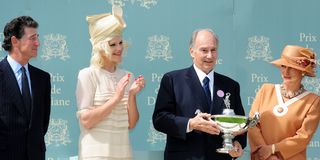
(L-R) Baron Edouard de Rothschild, Micky Green, his Highness the Aga Khan and Princess Zahra Aga Kahn at the awarding ceremony following the 161st Prix de Diane horse racing at Chantilly horsetrack near Paris, France, on June 13, 2010.
To the Aga Khan, Ismailism was more than just a religion.
“The Imam concerns himself with all of his people’s needs,” he remarked in 1962, underscoring his commitment to their spiritual and worldly welfare.
The Aga Khan regarded Ismailis “a transnational community”, reflecting their global presence and shared identity beyond national borders.
Unknown to many, in his early years, Aga Khan was a “devoted skier and so good at the sport that he was being mentioned as a possibility for Britain’s Olympic team in 1964”, according to newspapers. He, however, skied for Iran at a Winter Olympics.
One of his first projects was the Aga Khan Platinum Jubilee Hospital in Nairobi, which was a continuation of his grandfather’s interest in educational and charitable work. It has now expanded to a university hospital.
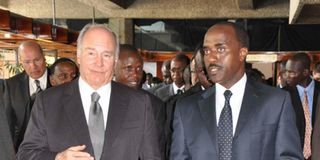
His Highness the Aga Khan and Linus Gitahi at a past event.
In his own style, the Aga Khan became the visionary founder of the AKDN that works with development agencies worldwide, with a particular focus on Africa, South and Central Asia and the Middle East. Prioritising healthcare and education, the AKDN funds hundreds of rural hospitals and schools, builds factories, luxury hotels and eco-tourism resorts and develops housing, water and sanitation systems across Asia and Africa.
For most of his years, the Aga Khan’s nerve centre was the Aiglemont estate in France.
It was his love for architecture that would also see him salvage heritage sites. In 1998, The New York Times described him as “the most important figure in the world of architecture today” following the Aga Khan Awards for Architecture.
It is said that the Aga Khan’s interest in architecture stemmed from his experience as a dissatisfied client, frustrated with the poor quality of schools, hospitals, housing and other projects he had commissioned to serve Ismaili communities.
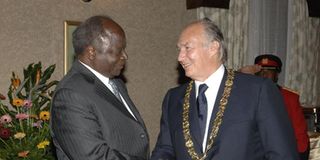
His Highness the Aga Khan greets former Kenya President Mwai Kibaki at a past meeting.
The Aga Khan was also involved in programmes to restore historic cities, including projects in Cairo and Zanzibar. The Aga Khan Trust for Culture was key to the restoration of the Humayun’s Tomb site in Delhi.
There is an annual Aga Khan Award for Architecture. He also funded the study of Islamic architecture at Harvard University and the University of Pennsylvania.
Over the years, the Aga Khan became one of the most studied figures of his time.
Scholars, such as Jonah Steinberg, who has studied the Ismaili community, described him as embodying social, political and spiritual roles and as an intermediary between the divine and human realms.
“Only he is sanctioned to prescribe doctrine and practice,” Steinberg says.
While his family had a storied legacy as racehorse owners, Aga Khan IV initially did not inherit any of the prized stables. A spokeswoman once downplayed his interest in horse racing, calling it “the least of his priorities”.
For many years his grandfather presided over what the media described as a “Thoroughbred Empire” with some of the finest horses in the world.
Yet, upon assuming his role, the young Prince Karim quipped: “I don’t know what I will do with the horses.”
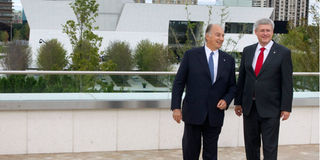
Canada's Prime Minister Stephen Harper and his Highness the Aga Khan stand on a terrace overlooking the Aga Khan Museum in Toronto September 12, 2014. The two officially opened the Ismaili Centre and Aga Khan Museum in Toronto.
However, he had little reason to worry. In a separate arrangement, the horses were divided among a group of relatives, excluding him.
Despite this, fate would eventually draw him into the racing world. After his father’s death in a motor accident, the Aga Khan IV inherited a portion of his thoroughbreds, setting the stage for his own influence in the sport.
But it was in the charity works that the Aga Khan became a global leader as he poured billions of dollars into service for humanity, building institutions that would improve lives.
The Aga Khan is survived by three sons and a daughter. His burial will take place in Lisbon.


